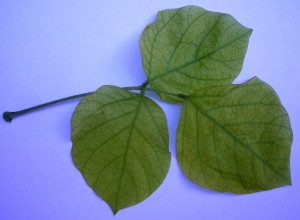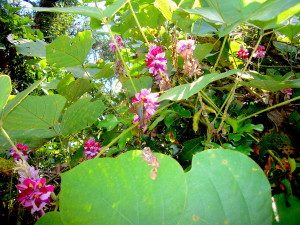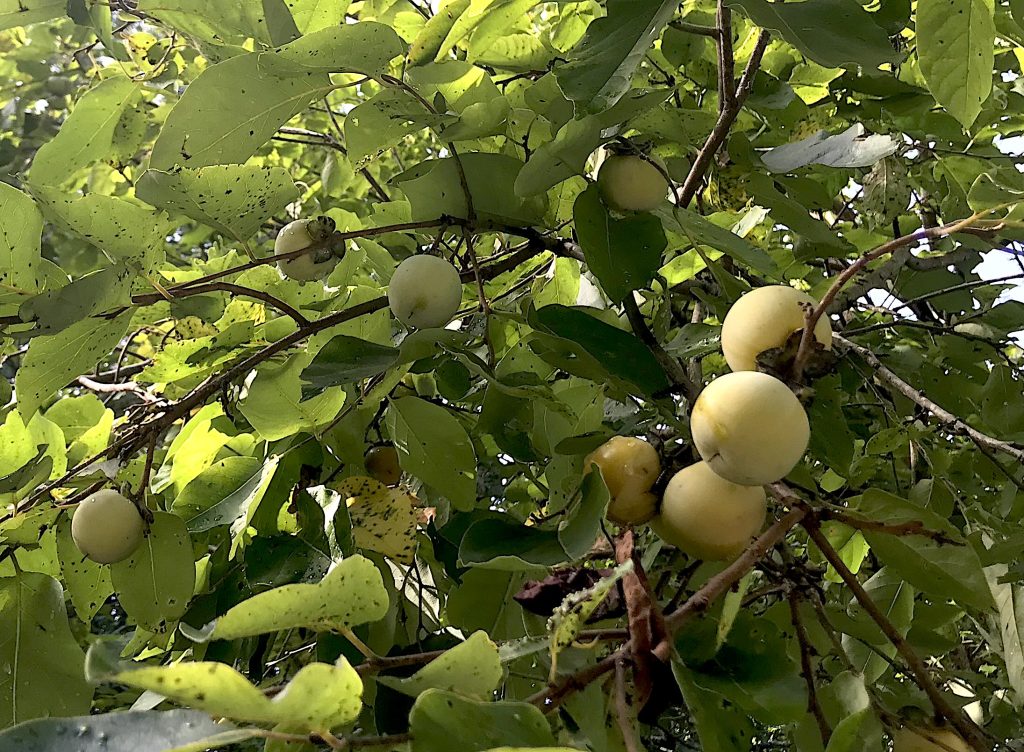
Ripe persimmons are dark orange and soft. Photo by Green Deane
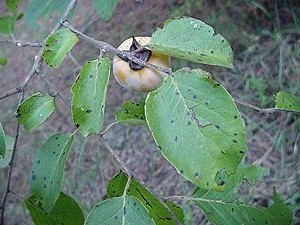
Persismmon leaves as a tea are very high in vitamin C. photo by Green Deane
Perhaps it will be a “banner” year for Persimmons, locally. All the persimmon trees I’ve seen this year are fruiting well. When will they ripen? I have found ripe ones as early as late July and as late ones in early January, I aim for October first. Persimmons are much maligned because they are astringent until extremely ripe. From the tree’s perspective it does not want the fruit carried away by animals that can taste sweet until the seeds are ready to germinate. So the fruit stays non-palatable to most creatures until the last moment. The fruit seemingly turn sweet overnight. No frost is needed. As Forager Dick Deuerling used to say the best persimmons are the ones you have to fight the ants for. Remember, the place to look for Persimmons trees are along edges…. edges of forests, edges of roads and rivers and paths. To read more about the Persimmon, which is North American’s only ebony, go here.
Kudzu is known as the plant that smothered The South. It leaves the impression that if you fell asleep in a lawn chair at noon by supper time you would be covered by Kudzu. Driving or hiking through places like North Carolina one can see steep hillsides thickly blanked with the large, herbaceous vine. But it is the botanical beast it’s purported to be?
What’s important to us is that nearly the entire plant is edible: Leaves, growing tips, grape-scented blossoms, young roots and older root starch. Only the seeds are not edible by humans. However the plant does support wild life and domestically goats are particularly fond of it. Turning Kudzu into goat products is profitable, tasty and sustainable. While Kudzu can be a local problem its invasiveness has been exaggerated by regional writers.
Kudzu was first championed during the Dust Bowl Era in the 1930’s because it was the prime plant for fighting erosion. Folks were paid to sow it on their land (no complaining then.) About a million acres were planted in the next 20 years then the program ended. Kudzu meanwhile had worked its way into southern novels and folksy observations. It became a southern cliche. In reality Kudzu occupies about one tenth of one percent of the South’s 200 million acres of forest, or 227,000 acres. Asian Privet, which is rarely commented on by anyone, occupies some 3.2 million acres, 14 times that of Kudzu. The Kudzu is spreading but at a thousandth-something rate of around 2,500 acres a year. And in time it might be significantly reduced: A few years ago a Japanese Kudzu bug was found in a garden in Atlanta (a city which is six times the size of the Kudzu infestation.) The bug was a stowaway on some plane. It is now successfully devouring Kudzu. In one test site it ate a third of the Kudzu in two years. In decades to come Kudzu might be but a bucolic memory, a quaint reference to how it used to be. To read more about Kudzu, go here.
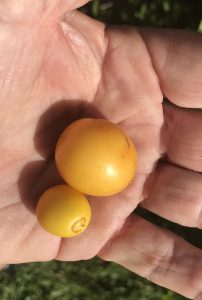
The deeper the yellow the sweeter the plum is.
We are definitely coming into tallow plum season. We have found ripening ones in Melbourne, Ft. Pierce and near Tampa. They will fruit into the fall. Tallow plum is a fruit you eat in moderation, a few here, a few there, They do contain some hydrocyanic acid. I have read of some people boiling the leaves and eating them but that is not on my list of things to do. Although found throughout the state they seem to be easier to locate in coastal areas a few miles from shore ,and, where you find one there will be more. To learn more about the Tallow Plum go here.
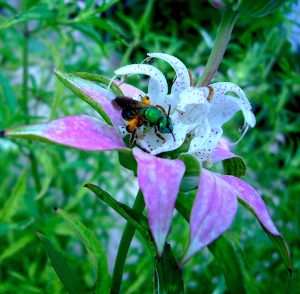
Monarda punctata, Horsemint, Beebalm. Photo by Green Deane
Wild mints can be prima donnas: Once on stage they hate to get off. Locally we would expect to see Horsemint, Monarda punctata in full bloom by September but it has pushed the season and can be found now. The species can also flower for several months. This week I saw a nice stand along a bike trail in south Vousia County, exactly where one would expect to find it: On a dry bank up from the trail. You can also find it in the same area near roads especially roads that cut through a sand hill. It was also starting to look pretty in La Strange Preserve in Ft. Pierce. Look for the showy pink bracts. If you want to read about Horsemint you can go here.

Foraging classes are held rain, shine, hot or cold. Photo by Nermina Krenata
Foraging classes: Classes this week range from the middle of the state to the southeast coast. It warm weather, dress to stay cool while walking and have water.
Saturday, July 30th, Mead Garden: 1500 S. Denning Dr., Winter Park, FL 32789. Meet at the bathrooms. 9 a.m.
Sunday, July 31th, Dreher Park, 1200 Southern Blvd., West Palm Beach, 33405. Meet just north of the science center 9 a.m.
Saturday, August 6th, Red Bug Slough Preserve, 5200 Beneva Road, Sarasota, FL, 34233, 9 a.m. Meet at the playground.
Sunday, August 7th, Boulware Springs Park, 3420 SE 15th St., Gainesville, FL 32641. Meet at the picnic tables next to the pump house. 9 a.m.
For more information, the pre-pay for a class, or sign up go here.
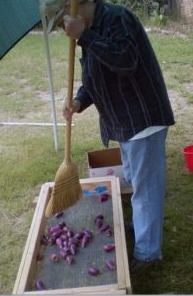
Sweeping clochids off catus is another option.
Most foragers know cactus have edible parts but what does one look for, generally? First make sure it’s a pad, segmented often oval or tear-drop shaped. You do not want anything that looks serpentine. Also no white sap. White sap in plants that resemble cactus can be very deadly even after being dry many years. In one case smoke from burning desiccated Euphorbia branches killed some stranded people. They were trying to stay warm around the fire on a cold desert night. So, pads, no white sap. While which cactus you collect (Opuntia, Nopales, or Cereus) might be the luck of the draw, the less spines the better, and the less glochids the much better. Glochids are tiny tuffs of sharp hair that hurt, are hard to dig out, and last for days. Ma Natures knows the pads and Tuna are good food so she protects them mightily. Big spines can be cut, burned or scraped off, glochids burned or washed off. Just scraping is not so successful with glochids. Wear stiff gloves without seams. Those little glochids will pass right through seams and get ya. Hint: Young pads, the ones we want anyway, often have not developed glochids. The Tuna have them so pick with tongs and sweep, wash or burn the painful spines off. Let us presume you have a spineless, glochidless young pad. What do you do with it? You can eat it raw, skin and all, or roast it or boil it. I know one restuarant that steams them (preserving color) then lightly grills them puting the pads whole on a Mexicanesque hamburgers. With older (de-spined) pads you can still eat them raw or cook. Usually the tougher spine “eyes” are removed just like you would with a potato. And the pad can be peeled as well. Pads at a certain point become woody and too tough to eat. The fruit, Tunas, are also edible after ridding them of glochids. They can have a raspberry flavor. The seeds are edible, too, but are extremely tough. You have to grind or roast them To read more about cactus click here.

You get the USB, not the key.
Changing foraging videos: As my WordPress pages are being updated the video set will go away. They are the same videos I have on You Tube. Some people like to have a separate copy. The DVD format, however, is becoming outdated. Those 135 videos plus 36 more are now available on a USB drive. While the videos were played from the DVDs the videos on the USB have to be copied to your computer to play. They are MP4 files. The 171-video USB is $99. If you make a $99 “donation” using the link at the bottom of this page or here, that order form provides me with your address, the amount — $99 — tells me it is not a donation and is for the USB.

Green Deane Forum
Want to identify a plant? Perhaps you’re looking for a foraging reference? You might have a UFO, an Unidentified Flowering Object, you want identified. On the Green Deane Forum we — including Green Deane and others from around the world — chat about foraging all year. And it’s not just about warm-weather plants or just North American flora. Many nations share common weeds so there’s a lot to talk. There’s also more than weeds. The reference section has information for foraging around the world. There are also articles on food preservation, and forgotten skills from making bows to fermenting food.
This is weekly newsletter #517, If you want to subscribe to this free newsletter you can find the sign-up form in the menu at the top of the page.
To donate to the Green Deane Newsletter click here.

